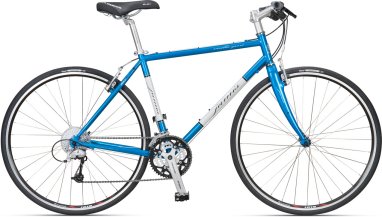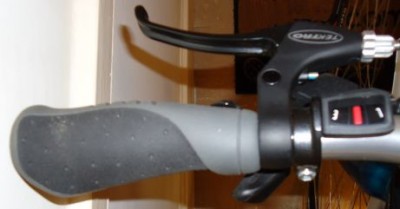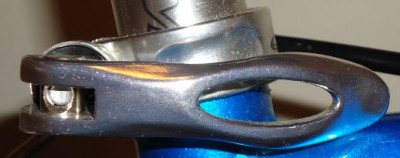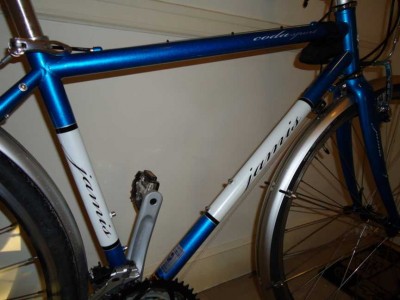Too often, online product reviews convey subjective views in the guise of objectivity. There are many ways to view any product. Personal bias colors what each of us perceives, no matter how hard we may try to be objective; so, let me disclose the fact that I wanted this bike for a long time before I bought it. (Yes, I bought it.) After reading my review, you may or may not decide to do the same.
From my post entitled Quest for a Sub-$1000 Steel Bicycle you can learn about how I decided to buy a Jamis bicycle. The most obvious reason was my partiality for steel bikes. I studied all of the bikes in the Jamis Coda line. Based on my analysis of the 2009 and 2010 models, I concluded that the differences between the Coda (the entry level model) and the Coda Sport (the mid-level model) were minuscule. The frames were identical, making the ride identical.
In my view, unless you were buying high-end components, the components wouldn’t make enough of a difference to warrant spending several hundred dollars more for a bike – assuming that both bikes had the same frame. All things being equal, it made sense to buy the entry level Coda with a view to upgrading it in the future. That way, you could get the frame (the best part of the bike) for the least amount of money. Down the road you could choose your own components and tailor it to your tastes.
To complicate matters, there was another bike in the Coda line, the Coda Comp. This was a “higher-end” Coda. The components were a step up and one feature in particular appealed to me – a carbon fork.
Some people are happy with a steel fork. Usually, I am too. But, there’s nothing like the ride of a carbon fork. It has a yielding softness which melts away the peaks and valleys of pockmarked roads. When paired with steel, it adds a velvety touch to an already smooth ride. I wanted that fork. The Coda Comp’s price, $950, kept me from choosing it. I was looking for an all-purpose transportation/utility bike. Minimizing cost and the practicality of locking it outdoors were of primary importance.
Thinking along those lines, I decided to test ride all three models. Figuring out my frame size and locating the bikes was a formidable task. It was the end of the 2010 season, and apparently Jamis Codas sold well. I found two 2010 Codas, one 2010 Coda Sport and one 2009 Coda Comp. After trips to several bike shops (as luck would have it, each had only one model in my size), I rode all three. I liked the ride of the Coda Comp best, but after the test rides I decided to purchase the Coda. It was the least expensive model with the most potential.
Now comes the good part. I was reading the specs on Jamis’s site when I noticed information on the 2011 models. Out of curiosity I compared the 2010 and 2011 Coda models. Immediately, one thing struck me: Jamis had discontinued the Coda Comp and kept the top-of-the-line Coda Elite ($1,000 MSRP). Then, with a stroke of brilliance, they had put the Coda Comp’s carbon fork on the Coda Sport (the mid-range model). It looked as if they had combined the two bikes.
This was somewhat eerie because I had been craving that carbon fork, but didn’t want to spend $950 on a bike. It was as if Jamis had heard my prayers and put the fork I wanted on the less expensive model. With this piece of knowledge came a dilemma: I wanted to buy a bike by November, but the 2011 Codas wouldn’t be available for another month or two.
I thought long and hard. Something about the 2011 Coda Sport appealed to me in an indescribable way. The carbon fork (carbon fiber unicrown with brake mounts, low-rider carrier mounts and forged dropouts with single eyelet) had a lot to do with it.
The frame specs were: Reynolds 520 double-butted chromoly main tubes, extended head tube with reinforced collars, double tapered cromo stays, and forged dropouts with eyelets. Additional specs included a 27-speed trigger shifting drivetrain with 48/36/26 FSA DynaDrive crankset, Shimano Deore rear derailleur, Alivio shifters, 11-32 Shimano cassette, Tektro direct-pull brakes with front power modulator and Tektro alloy levers, and Selle San Marco’s Elba saddle. (See full specs here.)
Specs aside, it was just one of those moments when you connect with a bike for some indiscernible reason. I needed a bike. However, I knew I would be sorry if I bought the 2010 Coda only to see the 2011 Coda Sport later – and be struck with buyer’s remorse. It was the sort of decision you only make once, and it had to be right.
Patience has always been one of my virtues. I put down a deposit to reserve a 2010 Coda and waited for the 2011 Coda Sport to become available. Weeks passed and I nearly gave up hope until one day a local shop e-mailed me with news: they had spoken to the Jamis rep who said that the 2011 Coda Sport was available on the West Coast. They could arrange to have one sent to Boston for me.
I jumped at the opportunity. A couple of weeks later, the 2011 Coda Sport arrived. It was assembled the next day and ready to test ride. As soon as I saw the bike, I knew it was mine.
Sporting striking blue and crisp white colors (aptly named Monterey Blue/Pearl White) not at all like the color on Jamis’s website, it was eye-catching. Parenthetically speaking, Jamis needs to hire a better photographer because the color in their photos doesn’t do the bike justice.
Personal views would dictate whether the color was a good or bad thing. Previous years’ models had muted, sometimes nauseatingly theft deterring colors suitable for crime-ridden neighborhood parking. For those with a sense of aesthetics, the newer, bolder color might be appealing, although some might consider the attractive color too appealing to the dishonest among us. Nine times out of ten aesthetics trumps practicality for me, so I was content with the bike’s color.
Unlike recent Coda models, the 2011 Coda Sport’s components were chrome, not black. If you’re neurotic like me, you may not be able to tolerate the scratching off of paint that goes along with black components. Jamis’s move to chrome meant that my bike would look new longer.
I also bade good riddance to the previous year’s suspension seat post whose departure shaved off some weight. I’m not a fan of suspension seat posts for urban riding. I’d rather have a lighter bike. And, a regular alloy seat post is one less thing to wear out.
Combined with the carbon fork and a change in components, Jamis shaved a noticeable amount of weight off of the Coda Sport. I haven’t weighed either the Coda or Coda Sport, but I will say that the 2011 Coda Sport feels lighter than the Coda (according to Jamis, the Coda Sport weighs 25.75 lbs).
As soon as the 2011 Coda Sport was ready, I took it out for a ride. The ride was exactly as I had imagined. For a bike in its price range ($725), it felt lighter and quicker than expected. Gliding effortlessly, the carbon fork soaking up every imperfection in the road, the Coda Sport was responsive and handled corners well. I shifted the gears through their full range. The shift levers felt crisp and the shifting was precise. The Selle San Marco Elba saddle was pleasantly comfortable for a stock saddle. Overall, the ride was comfortable.
The only thing I was conflicted about was the quick release seatpin. It did make adjusting the saddle height a breeze, but a strategy had to be devised for how to handle this “feature” when locking the bike outdoors. The saddle and seat post could be secured to the frame, the seat post could be removed and taken with you or the quick release seatpin could be replaced altogether. In the short run, the quick release was a good thing for someone like me who was not accustomed to riding a bike with a more upright posture. A few tries were necessary to get the seat height exactly right.
How you plan to use a bike and how long you plan to keep it will factor into whether you believe that the Coda Sport is the right bike for you. Less expensive bikes can fill the role of the Coda Sport. However, very few sub-$1,000 steel bikes exist these days. If you’re in the market for a moderately priced steel bike, I would recommend taking the Jamis Coda Sport for a ride.
Update: I have posted additional information on carbon forks here.
Update #2: By request, here is a photo of the 2011 Jamis Coda Sport frame for the purpose of better representing the bike’s color.
(click on photo to enlarge)
Update #3: Bicycling Magazine has given the Jamis Coda Sport its Editors’ Choice Award for best flat-bar road bike. Here is what they wrote:
“Supple ride characteristics make this bike a winner. Nearly any rider will be comfortable and a mix of Shimano components are easy to use. The bike is equally capable when rolling quickly in fitness mode or when loaded for errands. We also love the paneled paint scheme.”
Update #4: (12/6/2011) Note to readers who are comparison shopping between Jamis 2011 and 2012 Coda bicycles: For the second year in a row, Jamis has changed the models in the Coda line. The bicycle discussed in this review, the 2011 Jamis Coda Sport, is comparable to the 2012 Jamis Coda Comp.
While Jamis makes great bicycles (my 2011 Coda Sport is now one year old, and it has served me well), they aren’t as good at marketing bicycles. If I ran Jamis, I would not have changed the names of the Coda models twice in a row. In fact, I can think of many reasons why they should have kept the 2011 model names. Nevertheless, since Jamis can’t make up their mind about what to call the bikes, we will have to fend for ourselves.
To properly compare the Coda bicycles, it’s necessary to understand the name changes Jamis has made over the last few years.
In 2010, Jamis had four bikes in the Coda line. The entry level bike was called the “Coda” (the signature bike of the line). The next step up in the line was the “Coda Sport.” Next was the “Coda Comp.” And, at the top of the line was the “Coda Elite.” There was also a women’s model, the “Coda Femme,” which was a Coda with women’s specific geometry.
In 2011, Jamis decided to eliminate one of the bikes in the line. To do this, they combined the Coda Sport and Coda Comp (as I described above) and called the resulting bike the “Coda Sport.” So, in 2011 the Coda line consisted of the Coda, Coda Femme, Coda Sport, and Coda Elite. There was no Coda Comp in 2011.
When planning for the 2012 model year, Jamis became dissatisfied with their 2011 naming choices and decided to rename two of the bikes. First, they eliminated the name “Coda,” and renamed the entry level bike as “Coda Sport.”
Second, was the renaming of the 2012 mid-level Coda from “Coda Sport” to “Coda Comp.” (A comparison of the 2011 Coda Sport and 2012 Coda Comp specifications shows that they are the same bike — with slightly upgraded components on the 2012 model.) Third, was the addition of a second women’s model, the “Coda Comp Femme.”
In summary:
Coda Product line:
2010: Coda, Coda Femme, Coda Sport, Coda Comp, Coda Elite
2011: Coda, Coda Femme, Coda Sport, Coda Elite
2012: Coda Sport, Coda Sport Femme, Coda Comp, Coda Comp Femme, Coda Elite
2011 Coda Sport = 2010 Coda Sport + 2010 Coda Comp (combined)
2011 Coda = 2012 Coda Sport
2011 Coda Femme = 2012 Coda Sport Femme
2011 Coda Sport = 2012 Coda Comp










